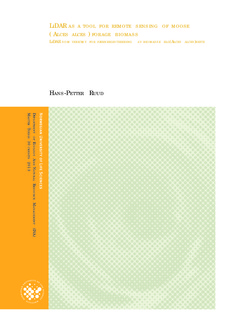| dc.contributor.author | Ruud, Hans-Petter | |
| dc.date.accessioned | 2013-08-23T09:18:09Z | |
| dc.date.available | 2013-08-23T09:18:09Z | |
| dc.date.copyright | 2013 | |
| dc.date.issued | 2013-08-23 | |
| dc.identifier.uri | http://hdl.handle.net/11250/187015 | |
| dc.description.abstract | Moose (Alces alces) play an ecological keystone role in the boreal forest ecosystem
and increasingly so during the last decades due to the large population increase. The growing
moose population has a large impact on forage plant species, including commercially
important tree species. Conversely, the quantity and quality of forage feedback on the body
weight and condition of the moose, which is a key trait for moose managers. To improve
moose management it is central to estimate and monitor “carrying capacity” over time and on
realistic management scales. In forest inventory remote sensing is extensively used with
different tools, such as LiDAR (Light Detection and Ranging).
This study examined the potential of LiDAR as a tool for remote sensing of moose
forage biomass. The study was conducted on a 735 km2 area, within the counties of Telemark
and Vestfold (N 59o20.285 E 9o39.664) in the south-eastern part of Norway. The field data
used in this study were collected during a moose forage study carried out in August 2007. The
field data included biomass data for 640 circular (2500 m2) plots. The LiDAR data used in
this study were collected in the years 2008-2010 for multipurpose. Three modeling
approaches were used: One model with only field inventory variables origin from forest
inventories (Forest model), one model with only LiDAR derived variables (LiDAR model)
and one model combining both forest and LiDAR variables. The aim was to asses if including
LiDAR derived information resulted in better models for moose forage biomass. All models
were mixed effects regression models.
For all combination of tree species and seasons, one or more LiDAR variables were
included in the best model. In the model validation the LiDAR + Forest models (r ranging
from 0.38 to 0.51) generally performed better than the pure Forest models (r ranging from
0.35 to 0.49) which again always performed better than the pure LiDAR models (r ranging
from 0.21 to 0.37). Important LiDAR variables like Understory LiDAR Cover Density
(ULCD) and Spacing Index (Spi) replaced forest variables such as cutting class in some of the
model groups. This study concludes that LiDAR can improve the ability to predict moose
forage biomass if variables from traditional forest inventory, such as site index, dominant tree
species, and cutting class, are added. Still, the validation revealed that models had low
generality. This study is based on field data with a relatively low spatial precision and with a
temporal mismatch between LiDAR and field data sampling. Future studies should sample
data simultaneously and with higher precision to investigate if large scale monitoring of
moose forage with LiDAR may become an operative tool in management. | no_NO |
| dc.language.iso | eng | no_NO |
| dc.publisher | Norwegian University of Life Sciences, Ås | |
| dc.subject | Moose | no_NO |
| dc.subject | LiDAR | no_NO |
| dc.subject | Forage biomass | no_NO |
| dc.subject | Remote sensing | no_NO |
| dc.title | LiDAR as a tool for remote sensing of moose (Alces alces) forage biomass | no_NO |
| dc.title.alternative | LiDAR som verktøy for fjernregisterering av biomasse elg (Alces alces) beite | no_NO |
| dc.type | Master thesis | no_NO |
| dc.subject.nsi | VDP::Mathematics and natural science: 400::Zoology and botany: 480::Ecology: 488 | no_NO |
| dc.subject.nsi | VDP::Agriculture and fishery disciplines: 900::Agriculture disciplines: 910::Management of natural resources: 914 | no_NO |
| dc.source.pagenumber | 43 | no_NO |
